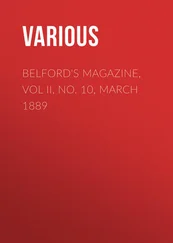Various - The Brochure Series of Architectural Illustration, Vol. 01, No. 03, March 1895
Здесь есть возможность читать онлайн «Various - The Brochure Series of Architectural Illustration, Vol. 01, No. 03, March 1895» — ознакомительный отрывок электронной книги совершенно бесплатно, а после прочтения отрывка купить полную версию. В некоторых случаях можно слушать аудио, скачать через торрент в формате fb2 и присутствует краткое содержание. Жанр: foreign_antique, foreign_home, periodic, visual_arts, на английском языке. Описание произведения, (предисловие) а так же отзывы посетителей доступны на портале библиотеки ЛибКат.
- Название:The Brochure Series of Architectural Illustration, Vol. 01, No. 03, March 1895
- Автор:
- Жанр:
- Год:неизвестен
- ISBN:нет данных
- Рейтинг книги:5 / 5. Голосов: 1
-
Избранное:Добавить в избранное
- Отзывы:
-
Ваша оценка:
- 100
- 1
- 2
- 3
- 4
- 5
The Brochure Series of Architectural Illustration, Vol. 01, No. 03, March 1895: краткое содержание, описание и аннотация
Предлагаем к чтению аннотацию, описание, краткое содержание или предисловие (зависит от того, что написал сам автор книги «The Brochure Series of Architectural Illustration, Vol. 01, No. 03, March 1895»). Если вы не нашли необходимую информацию о книге — напишите в комментариях, мы постараемся отыскать её.
The Brochure Series of Architectural Illustration, Vol. 01, No. 03, March 1895 — читать онлайн ознакомительный отрывок
Ниже представлен текст книги, разбитый по страницам. Система сохранения места последней прочитанной страницы, позволяет с удобством читать онлайн бесплатно книгу «The Brochure Series of Architectural Illustration, Vol. 01, No. 03, March 1895», без необходимости каждый раз заново искать на чём Вы остановились. Поставьте закладку, и сможете в любой момент перейти на страницу, на которой закончили чтение.
Интервал:
Закладка:
Various
The Brochure Series of Architectural Illustration, Vol. 01, No. 03, March 1895 / The Cloister at Monreale, Near Palermo, Sicily
THE CLOISTER AT MONREALE, NEAR PALERMO, SICILY
The island of Sicily, being in form nearly an equilateral triangle, with one side facing towards Italy, another towards Greece, and the third, towards Africa, was a tempting field for conquest to the various nations surrounding it. It was successively overrun by the Greeks, Carthaginians, and Romans, and later, after the Christian era, again successively by the Byzantines, the Moors, and the Normans. Almost all of the architectural remains of the older periods belong to the time of the Greeks, as neither the Carthaginians nor Romans left much to show for their occupation of the island. With the exception of occasional ruined examples surviving from the time of the Dorian Greeks who colonized Sicily, most of the monuments now existing belong to the Byzantine, Saracenic, and Romanesque periods. As would be natural to expect, the latter influences are not clearly separable one from another either in time or in locality. They overlap in all directions; but in general the Byzantine, which was the earliest and most powerful element, is found more strongly marked, and more frequently on the east coast. It however forms the groundwork and is the main ingredient of all that follows. The Saracenic work, which succeeds the Byzantine in date, found a stronger foothold in the South, on the coast nearest Africa; and the influence of the Normans appears in the North.
Every new race of masters in this frequent recurrence of conquest found the island already occupied by a very numerous population of extremely various origin. The newcomers could do no more than add their own forms to those previously in use; the consequence being in every case a mixed style, containing elements derived from every portion of the inhabitants.
Palermo, being on the northern coast, has felt the Norman influence strongly. Its architecture is principally Romanesque in form, with a generous admixture of Byzantine and Saracenic motives in detail and decoration. Exuberance of detail and wealth of color are the rule.
Under the Norman conquerors the Sicilians built as they were directed. Their arts and their civilization were superior to those of their masters, and the Normans were apparently willing to make use of this superiority, and merely adapted the forms of decoration and methods of construction which they found here in use to their own needs and purposes. The polychromatic decoration of the buildings of this neighborhood, such as the interiors of the Capella Palatina and the cathedral at Monreale, ranks among the most successful, if it be not the most successful, work of its class now in existence. It is thoroughly Oriental in character, although applied to buildings intended for Roman ritual. On account of the great superiority of the Moors in art and civilization, not only to the Normans but to all the other inhabitants at the time of the Norman conquest, in the eleventh century, many of the buildings of this period show very little Norman influence. In fact the Oriental character is so extreme in some instances, such as the church of San Giovanni degli Eremiti, that there is very little to suggest that it was Norman and intended for Norman uses.
The village of Monreale is situated on the steep mountain-side about five miles to the west of and overlooking the city of Palermo. The cathedral and the cloister-adjoining it on the south were both parts of a Benedictine convent, which is now mostly in ruins. They were erected by King William the Second, between the years 1174 and 1182, and richly endowed by him. The plan of the cathedral is that of a basilica.
The famous cloister, with coupled columns and clusters of four in the corners, and with a charming fountain and a separate little square of cloisters around it, as it were, in one corner of the open space, is one of the most interesting relics of Palermo. In arrangement it follows the style universal in the countries bordering on the Mediterranean, that is, consisting of a pointed arcade supported by small but elegant columns of Corinthian design, grouped in pairs; while in the North, in England, France, and Germany, a cloister is formed of a series of unglazed windows.
The columns surrounding the fountain, which unfortunately cannot be seen in the general view given in Plate XX., show the richest decoration. The shafts are either plain, rusticated, or covered with patterns executed in relief or mosaic.
There appears to be some doubt as to the date of this work, as the columns have evidently been inserted since the arches which spring from them were built. The discrepancy will be seen in Plates XVIII., XIX., and XX. The disproportion of the dainty columns and capitals to the heavy arches which are entirely in keeping with the architecture of the rest of the cathedral, but which manifestly do not fit the columns, leads to the conclusion that the columns were a later addition, although probably inserted soon after the other work was completed.
XVII. Capitals from the Cloister of Monreale, Sicily.
XVII.
CAPITALS FROM THE CLOISTER OF MONREALE, SICILY
The hybrid character of this work will be perfectly evident at a glance. It plainly belongs to none of the styles of the North, but nevertheless has a distinct character and unmistakable charm. The use of mosaic originally placed in the channels of the shafts added greatly to the decorative effect and airiness of these columns.
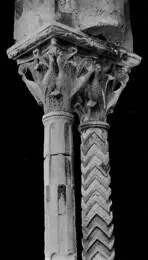
XVIII. Capitals from the Cloister of Monreale, Sicily.
XVIII.
CAPITALS FROM THE CLOISTER OF MONREALE, SICILY
A common device in most of the Romanesque cloisters for adding interest to the long colonnade was the grouping of two columns of dissimilar design. This plan is followed here in treating the mosaic inlay vertically in one and horizontally in the other.
XIX. Capitals from the Cloister of Monreale, Sicily.
XIX.
CAPITALS FROM THE CLOISTER OF MONREALE, SICILY
The design of the capitals shown in this plate follows the Corinthian model very closely.
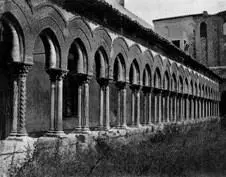
XX. The Cloister of Monreale, Sicily.
XX.
THE CLOISTER OF MONREALE, SICILY
In a later number of THE BROCHURE SERIES another view of this most charming building will be given. The portion surrounding the fountain, with its groups of four clustered columns, is, in many respects, the most beautiful portion of the structure This will be taken up later.
With the reign of Constantine, and the introduction of Christianity as the acknowledged religion of Rome, Byzantine art, as such, made its appearance. The culture of Rome was transferred to Byzantium, henceforth to be known as Constantinople. Governed alternately by Greek and by Persian, it had received a strong Oriental character from the Eastern nations, and had added to the Greek subtlety and delicacy of expression the Oriental love of detail. When converted by Constantine into New Rome, it became a perfect treasure house of Eastern and Grecian art. The Byzantine work, which spread over the East in the sixth, seventh, and eighth centuries, is therefore a union of the refinement of the Greek, the desire for color and detail of the Oriental, and the vigor of constructional invention and conception of mass and grandeur of the Roman. A portion of it was transplanted to Ravenna during Justinian's reign, and there is a glorious afterglow in the Venetian splendor of the tenth and eleventh centuries. The three great centres of Byzantine art work are Constantinople, Ravenna, and Venice; and the three most noted examples, the churches of Sta. Sophia, S. Vitale, and St. Mark's. Apart from these, the cathedral at Monreale, and the Capella Palatina in Palermo, Sicily, represent a variation from the Byzantine type affected by Moslem design.
Читать дальшеИнтервал:
Закладка:
Похожие книги на «The Brochure Series of Architectural Illustration, Vol. 01, No. 03, March 1895»
Представляем Вашему вниманию похожие книги на «The Brochure Series of Architectural Illustration, Vol. 01, No. 03, March 1895» списком для выбора. Мы отобрали схожую по названию и смыслу литературу в надежде предоставить читателям больше вариантов отыскать новые, интересные, ещё непрочитанные произведения.
Обсуждение, отзывы о книге «The Brochure Series of Architectural Illustration, Vol. 01, No. 03, March 1895» и просто собственные мнения читателей. Оставьте ваши комментарии, напишите, что Вы думаете о произведении, его смысле или главных героях. Укажите что конкретно понравилось, а что нет, и почему Вы так считаете.
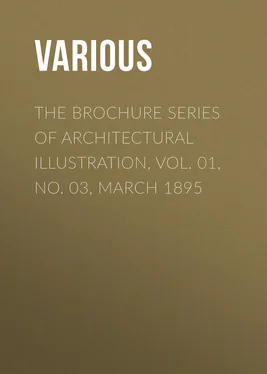





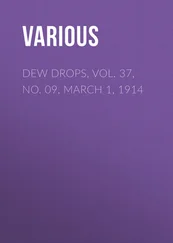
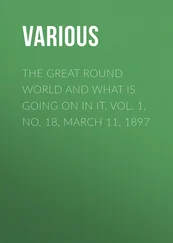

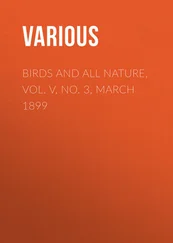
![Various - Birds and Nature Vol. 11 No. 3 [March 1902]](/books/745532/various-birds-and-nature-vol-11-no-3-march-1902-thumb.webp)
![Various - Birds and Nature Vol. 9 No. 3 [March 1901]](/books/745788/various-birds-and-nature-vol-9-no-3-march-1901-thumb.webp)
